Chromium-Coated Zirconium Cladding Neutronics Impact for APR-1400 Reactor Core
Abstract
1. Introduction
2. Design Parameters
2.1. Core Description
2.2. Materials
2.3. Core Configuration
2.4. Fuel Assembly and Core Models
3. Results
3.1. Various Enrichment Unit Cell Models
3.2. Reactor Assemblies Model Calculations
4. Two-Dimension Full Core Calculation
5. Conclusions
Author Contributions
Funding
Institutional Review Board Statement
Informed Consent Statement
Data Availability Statement
Conflicts of Interest
References
- Allen, P.L.; Ford, L.H.; Shennan, J.V. Nuclear Fuel Coated Particle Development in the Reactor Fuel Element Laboratories of the U.K. Atomic Energy Authority. Nucl. Technol. 1977, 35, 246–253. [Google Scholar] [CrossRef]
- Zinkle, S.; Terrani, K.; Gehin, J.; Ott, L.; Snead, L. Accident tolerant fuels for LWRs: A perspective. J. Nucl. Mater. 2014, 448, 374–379. [Google Scholar] [CrossRef]
- Bocock, G.; Oelrich, R.; Ray, S. Westinghouse EnCore registered accident tolerant fuel. Innovations for the future. Atw. Int. Z. Kernenerg. 2018, 63, 442–446. [Google Scholar]
- Yeom, H.; Maier, B.; Johnson, G.; Dabney, T.; Lenling, M.; Sridharan, K. High temperature oxidation and microstructural evolution of cold spray chromium coatings on Zircaloy-4 in steam environments. J. Nucl. Mater. 2019, 526, 151737. [Google Scholar] [CrossRef]
- Kim, H.-G.; Kim, I.-H.; Jung, Y.-I.; Park, D.-J.; Park, J.-Y.; Koo, Y.-H. Adhesion property and high-temperature oxidation behavior of Cr-coated Zircaloy-4 cladding tube prepared by 3D laser coating. J. Nucl. Mater. 2015, 465, 531–539. [Google Scholar] [CrossRef]
- Fejt, F.; Ševeček, M.; Frybort, J.; Novák, O. Study on neutronics of VVER-1200 with accident tolerant fuel cladding. Ann. Nucl. Energy 2019, 124, 579–591. [Google Scholar] [CrossRef]
- Charit, I. Accident Tolerant Nuclear Fuels and Cladding Materials. JOM 2018, 70, 173–175. [Google Scholar] [CrossRef]
- Younker, I.; Fratoni, M. Neutronic evaluation of coating and cladding materials for accident tolerant fuels. Prog. Nucl. Energy 2016, 88, 10–18. [Google Scholar] [CrossRef]
- Mouche, P.; Evans, A.; Zhong, W.; Koyanagi, T.; Katoh, Y. Effects of sample bias on adhesion of magnetron sputtered Cr coatings on SiC. J. Nucl. Mater. 2021, 556, 153251. [Google Scholar] [CrossRef]
- Barrett, K.E.; Teague, M.P.; Van Rooyen, I.J.; Bragg-Sitton, S.M.; Ellis, K.D.; Glass, C.R.; Roth, G.A.; McHugh, K.M.; Garnier, J.E.; Griffith, G.W.; et al. Engineering Challenges of LWR Advanced Fuel Cladding Technology in Preparation for In-Reactor Demonstrations; Oak Ridge National Lab (ORNL): Oak Ridge, TN, USA, 2012.
- Yang, J.; Steinbrück, M.; Tang, C.; Große, M.; Liu, J.; Zhang, J.; Yun, D.; Wang, S. Review on chromium coated zirconium alloy accident tolerant fuel cladding. J. Alloys Compd. 2022, 895, 162450. [Google Scholar] [CrossRef]
- George, N.M.; Terrani, K.; Powers, J.; Worrall, A.; Maldonado, I. Neutronic analysis of candidate accident-tolerant cladding concepts in pressurized water reactors. Ann. Nucl. Energy 2015, 75, 703–712. [Google Scholar] [CrossRef]
- Pasamehmetoglu, K.; Massara, S.; Costa, D.; Bragg-Sitton, S.; Moatti, M.; Kurata, M.; Iracane, D.; Ivanova, T.; Bischoff, J.; Delafoy, C.; et al. State-of-the-Art Report on Light Water Reactor Accident-Tolerant Fuels (No. NEA—7317); Organisation for Economic Co-Operation and Development: Paris, France, 2018.
- Terrani, K.; Zinkle, S.; Snead, L. Advanced oxidation-resistant iron-based alloys for LWR fuel cladding. J. Nucl. Mater. 2014, 448, 420–435. [Google Scholar] [CrossRef]
- Alaleeli, M.M.; Alameri, S.A.; Alrwashdeh, M. Neutronic Analysis of SiC/SiC Sandwich Cladding Design in APR-1400 under Normal Operation Conditions. Energies 2022, 15, 5204. [Google Scholar] [CrossRef]
- Alrwashdeh, M.; Alameri, S.A. SiC and FeCrAl as Potential Cladding Materials for APR-1400 Neutronic Analysis. Energies 2022, 15, 3772. [Google Scholar] [CrossRef]
- Alrwashdeh, M.; Alameri, S.A. Preliminary neutronic analysis of alternative cladding materials for APR-1400 fuel assembly. Nucl. Eng. Des. 2021, 384, 111486. [Google Scholar] [CrossRef]
- Do, M.; Nguyen, X.H.; Jang, S.; Kim, Y. Physics study for high-performance and very-low-boron APR1400 core with 24-month cycle length. Nucl. Eng. Technol. 2020, 52, 869–877. [Google Scholar] [CrossRef]
- Salazar, D.; Franceschini, F.; Petrarca, A.; Godfrey, A.T.; Stimpson, S.G.; Evans, T.M.; Collins, B.S.; Gentry, C.A. AP1000 PWR Cycle 1 Hfp Depletion Simulations with Vera-CS; Oak Ridge National Lab (ORNL): Oak Ridge, TN, USA, 2016.
- Alnoamani, Z.; Alameri, S.A.; Elsawi, M. Neutronic and Fuel Performance Evaluation of Accident Tolerant Fuel Concepts in APR1400 Reactor. Transactions 2018, 118, 1010–1013. [Google Scholar]
- Fridman, E.; Leppänen, J. On the use of the Serpent Monte Carlo code for few-group cross section generation. Ann. Nucl. Energy 2011, 38, 1399–1405. [Google Scholar] [CrossRef]
- Leppänen, J.; Pusa, M.; Viitanen, T.; Valtavirta, V.; Kaltiaisenaho, T. The Serpent Monte Carlo code: Status, development and applications in 2013. Ann. Nucl. Energy 2015, 82, 142–150. [Google Scholar] [CrossRef]
- van der Marck, S.C. Benchmarking ENDF/B-VII.1, JENDL-4.0 and JEFF-3.1.1 with MCNP6. Nucl. Data Sheets 2012, 113, 2935–3005. [Google Scholar] [CrossRef]
- Alrwashdeh, M. 239Pu evaluation comparison study. Ann. Nucl. Energy 2018, 118, 313–316. [Google Scholar] [CrossRef]
- Stanisz, P.; Oettingen, M.; Cetnar, J. Development of a Trajectory Period Folding Method for Burnup Calculations. Energies 2022, 15, 2245. [Google Scholar] [CrossRef]
- Alrwashdeh, M.; Kan, W. U233 data evaluation for criticality study. J. Nucl. Eng. Radiat. 2016, 2, 034501. [Google Scholar] [CrossRef]
- Alrwashdeh, M. Covariance data evaluation for 233U. Appl. Radiat. Isot. 2018, 133, 105–110. [Google Scholar] [CrossRef]
- JAEA Nuclear Data Center Home Page. Available online: https://wwwndc.jaea.go.jp/ (accessed on 16 February 2022).
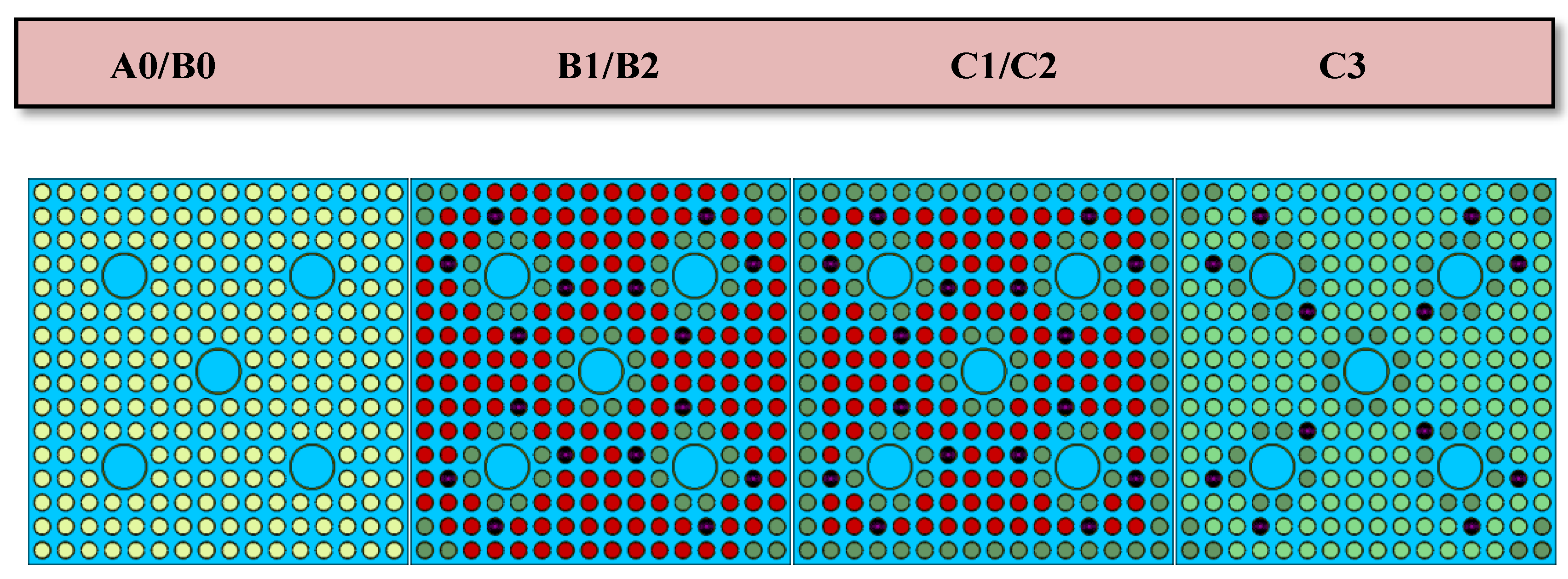
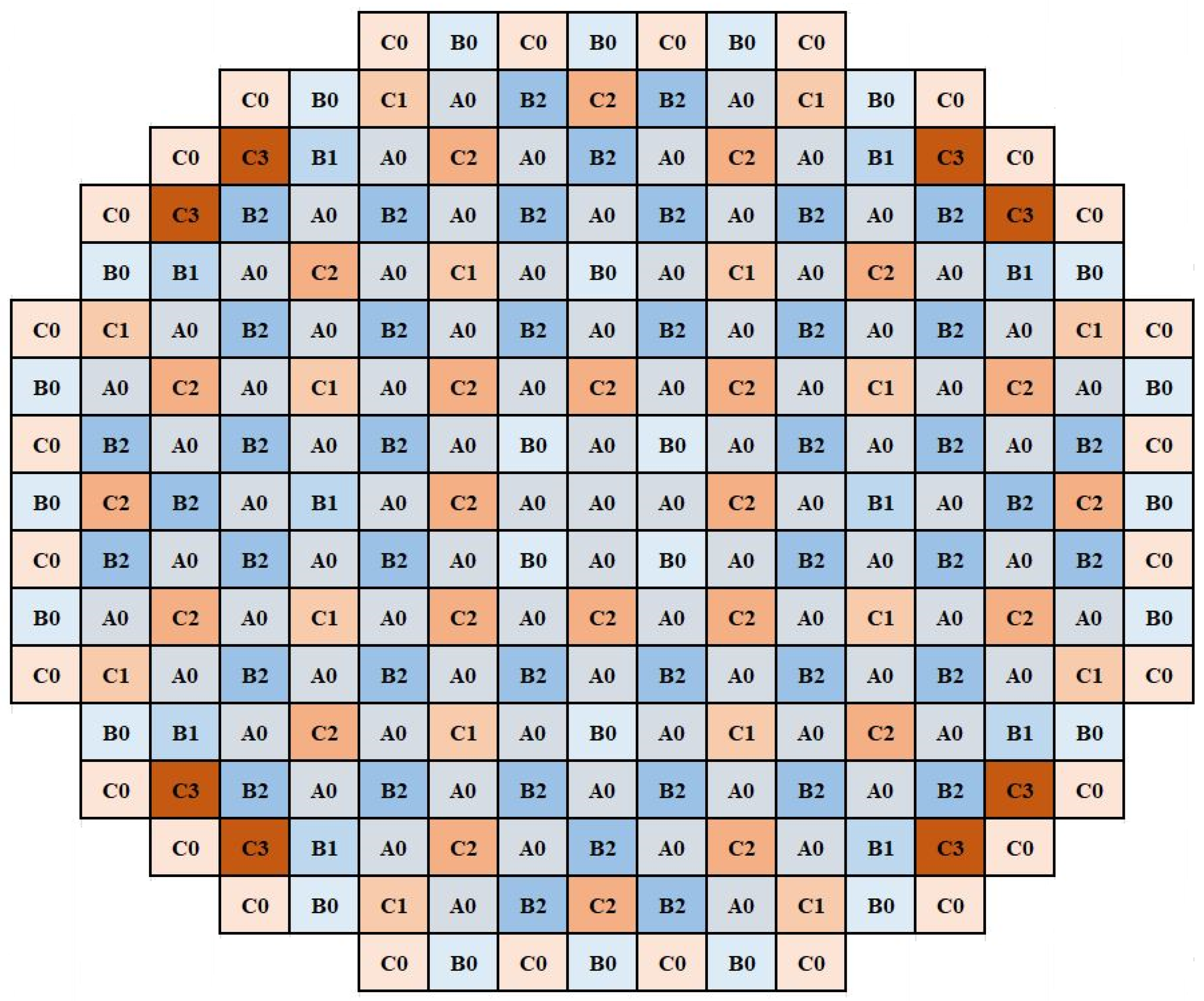

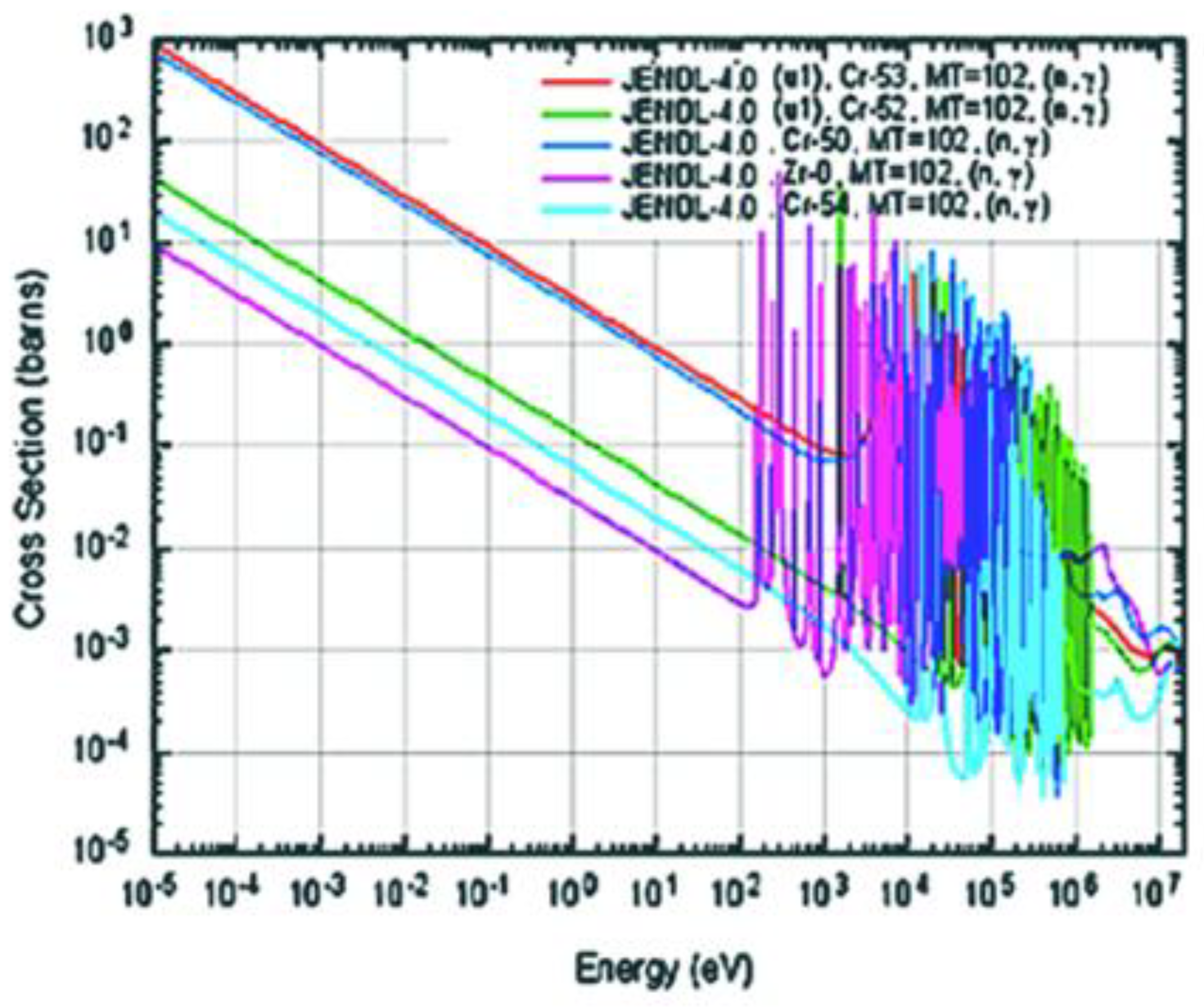
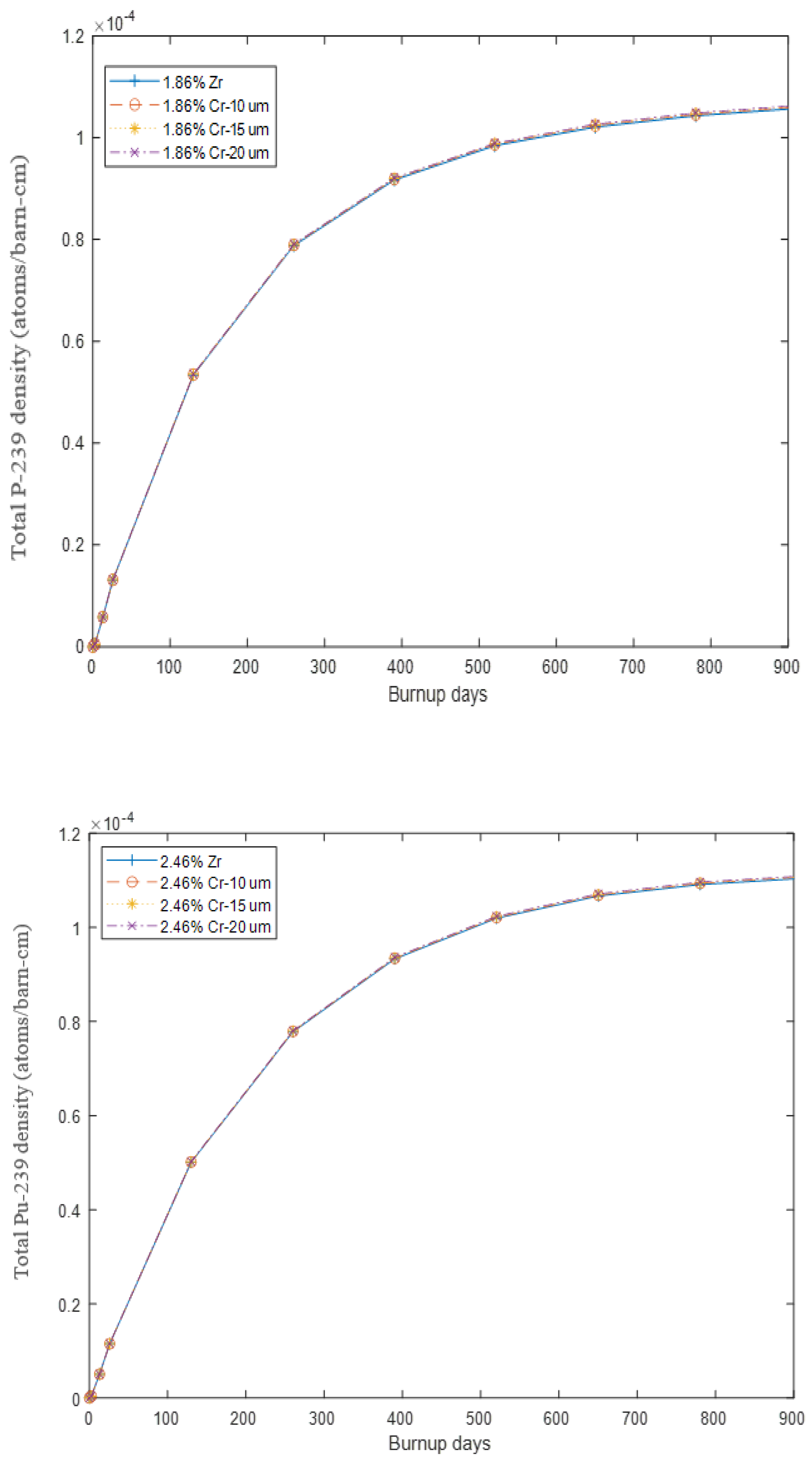

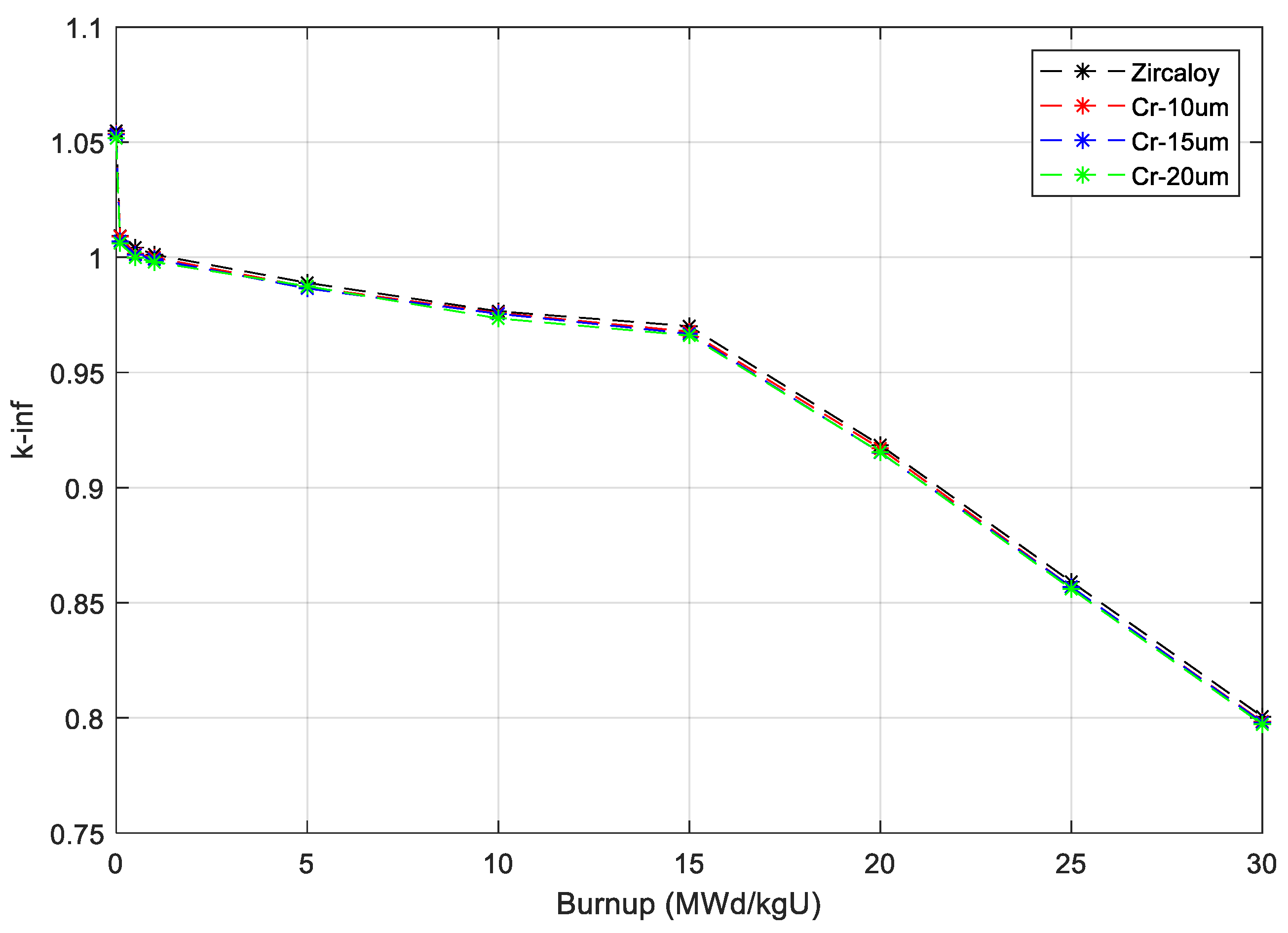

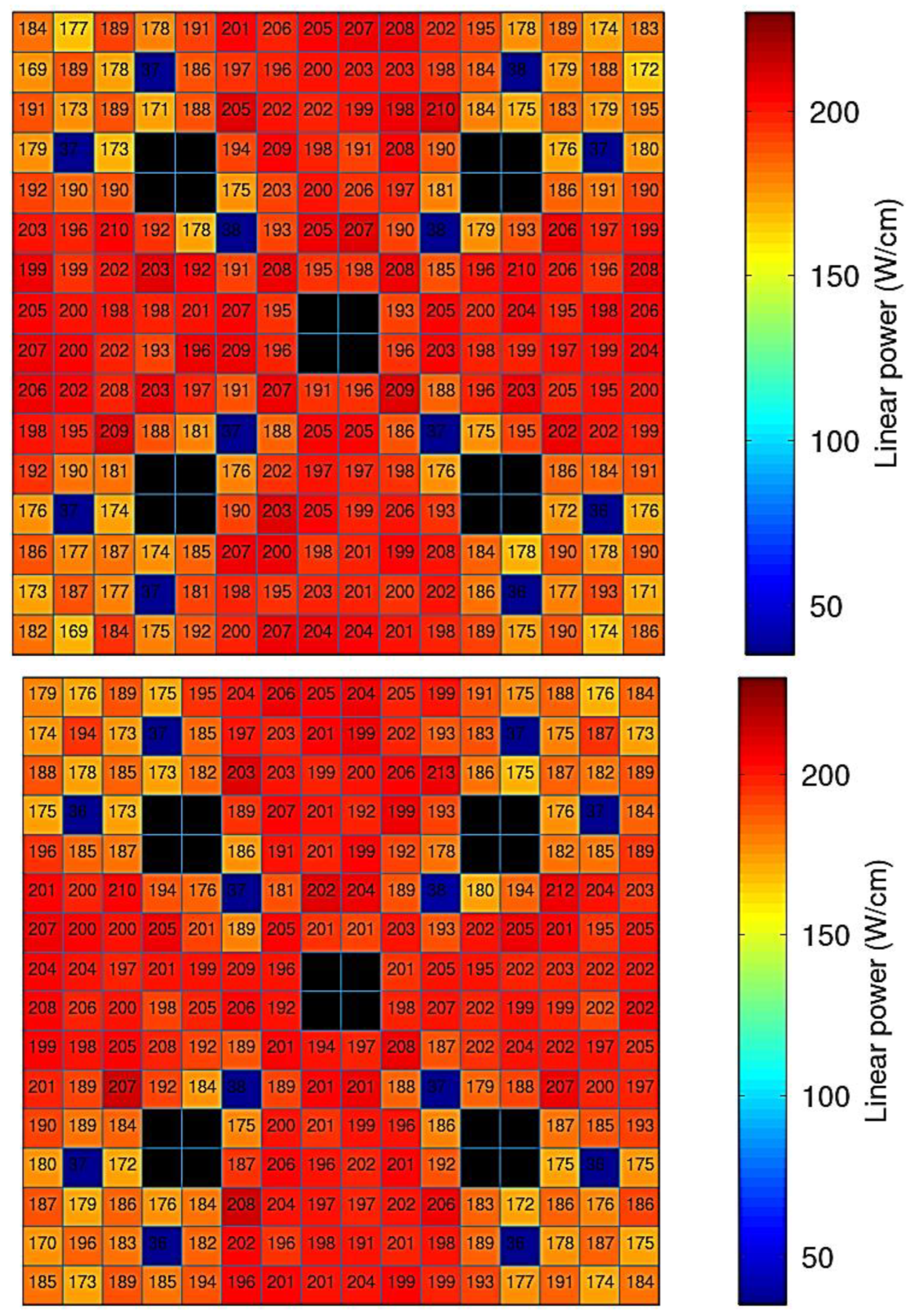
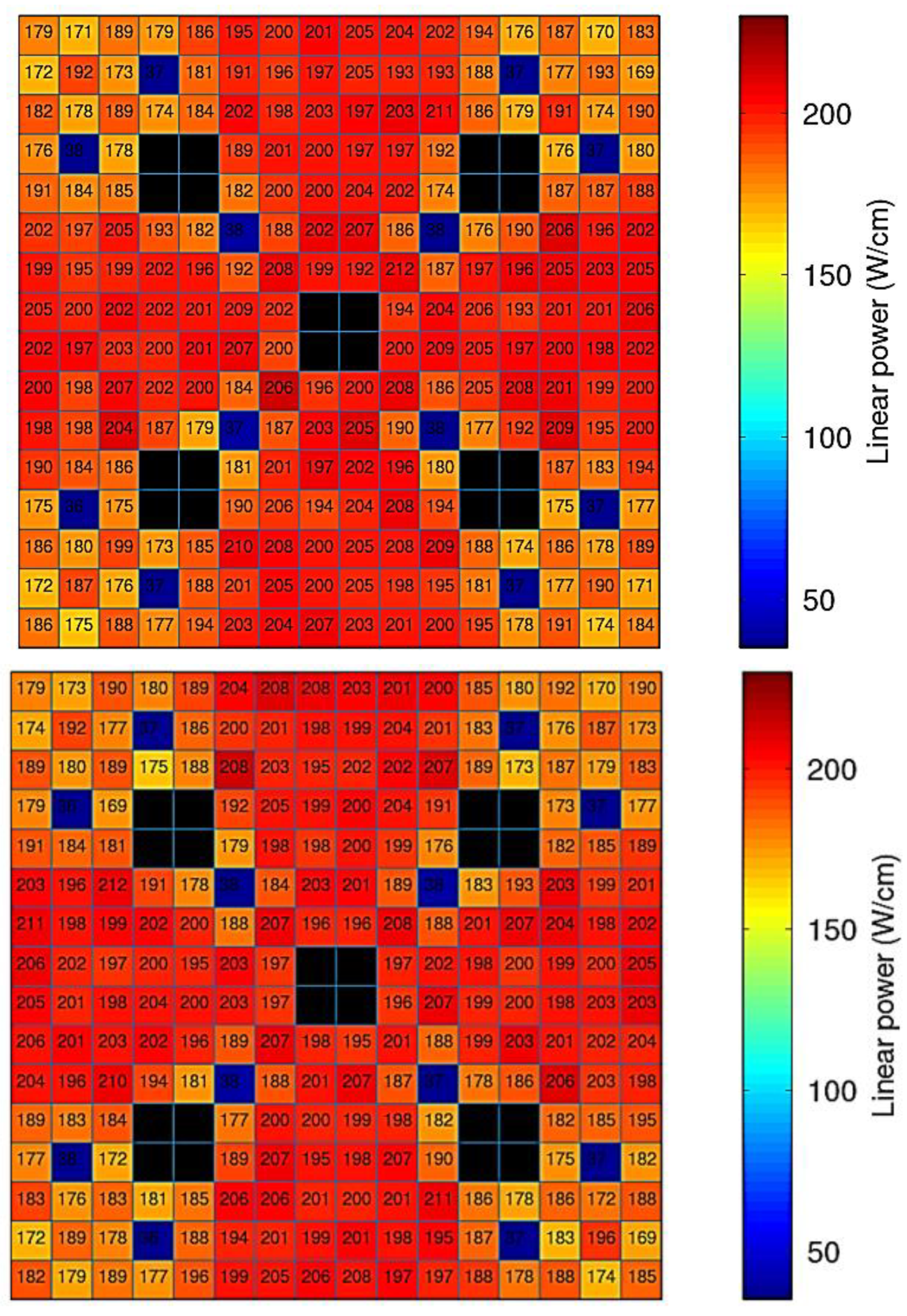
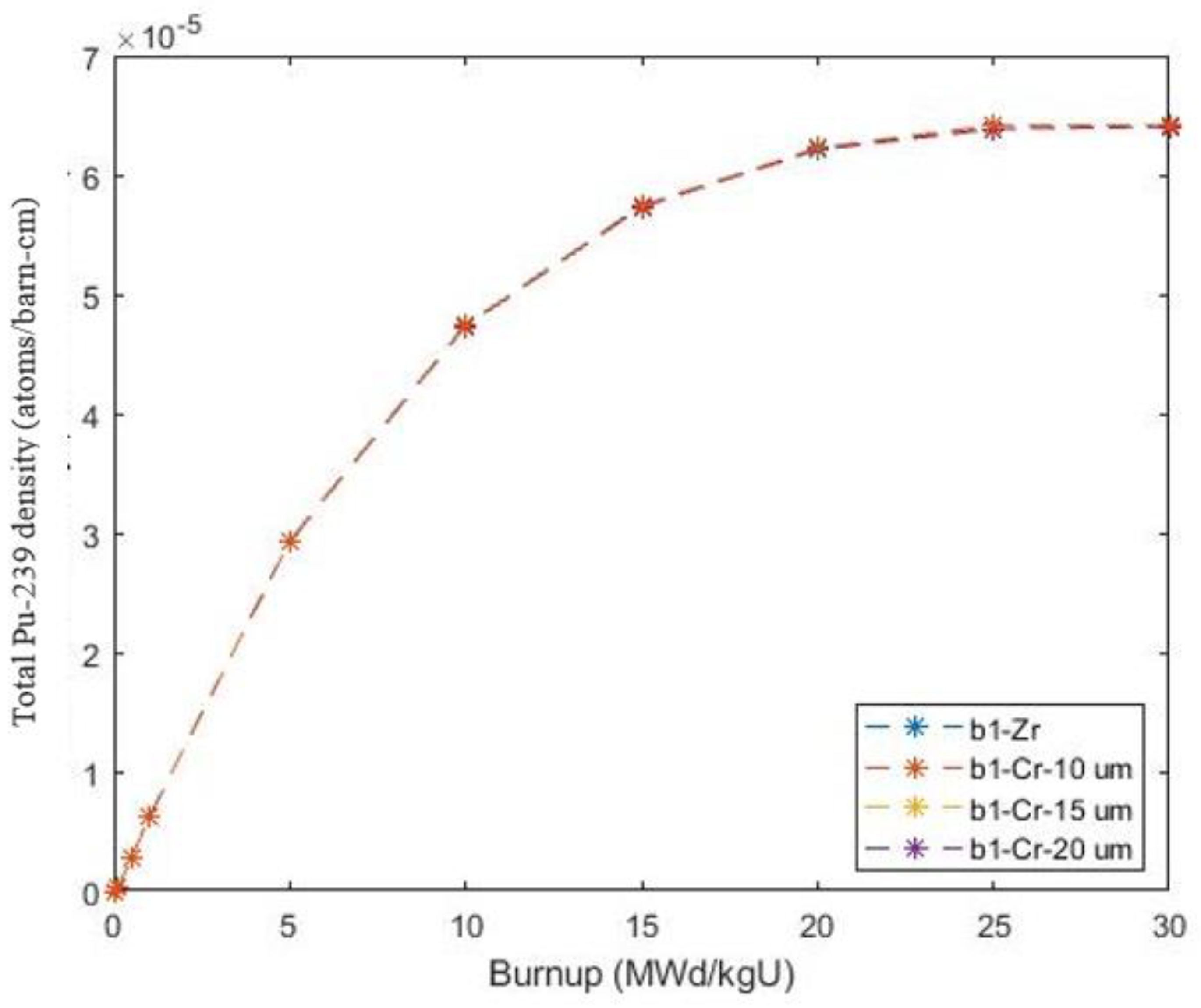
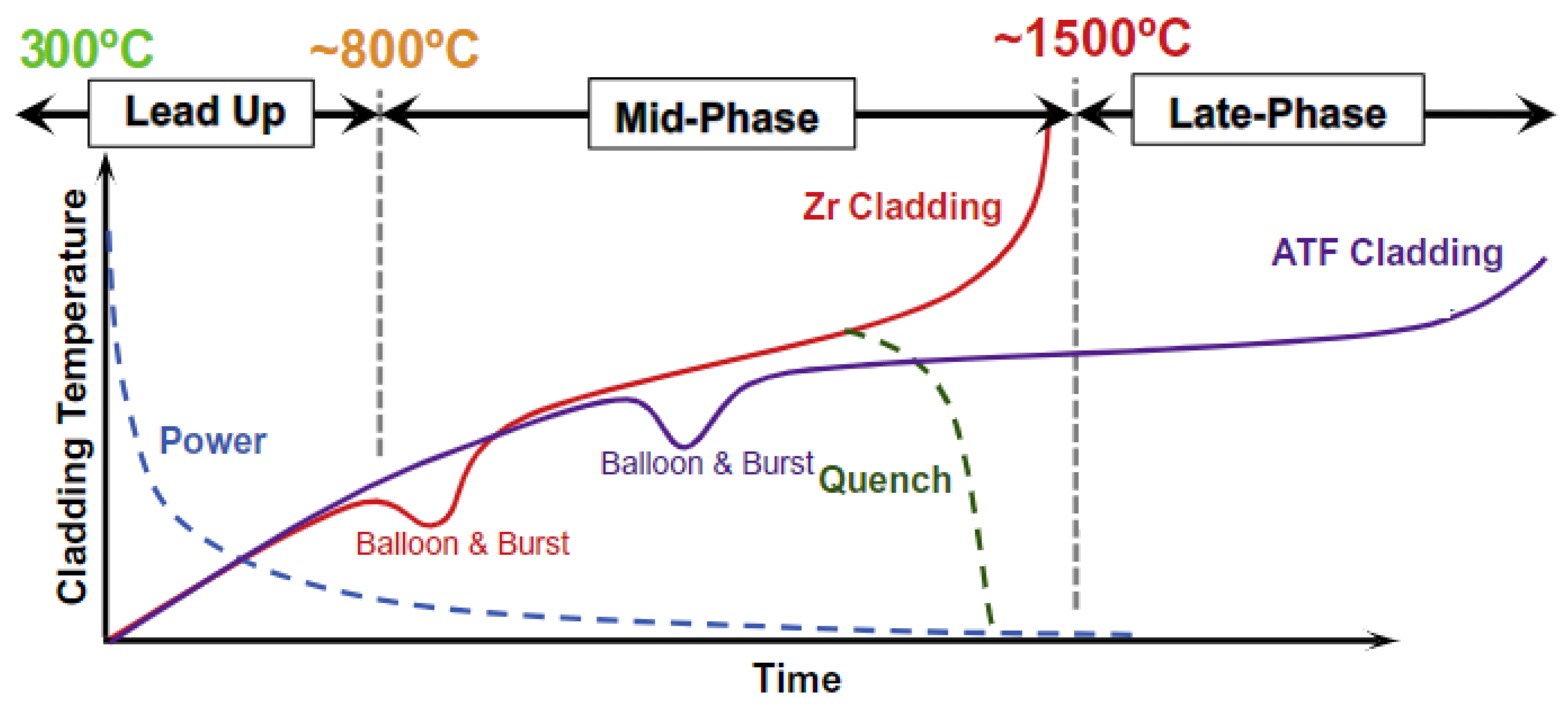
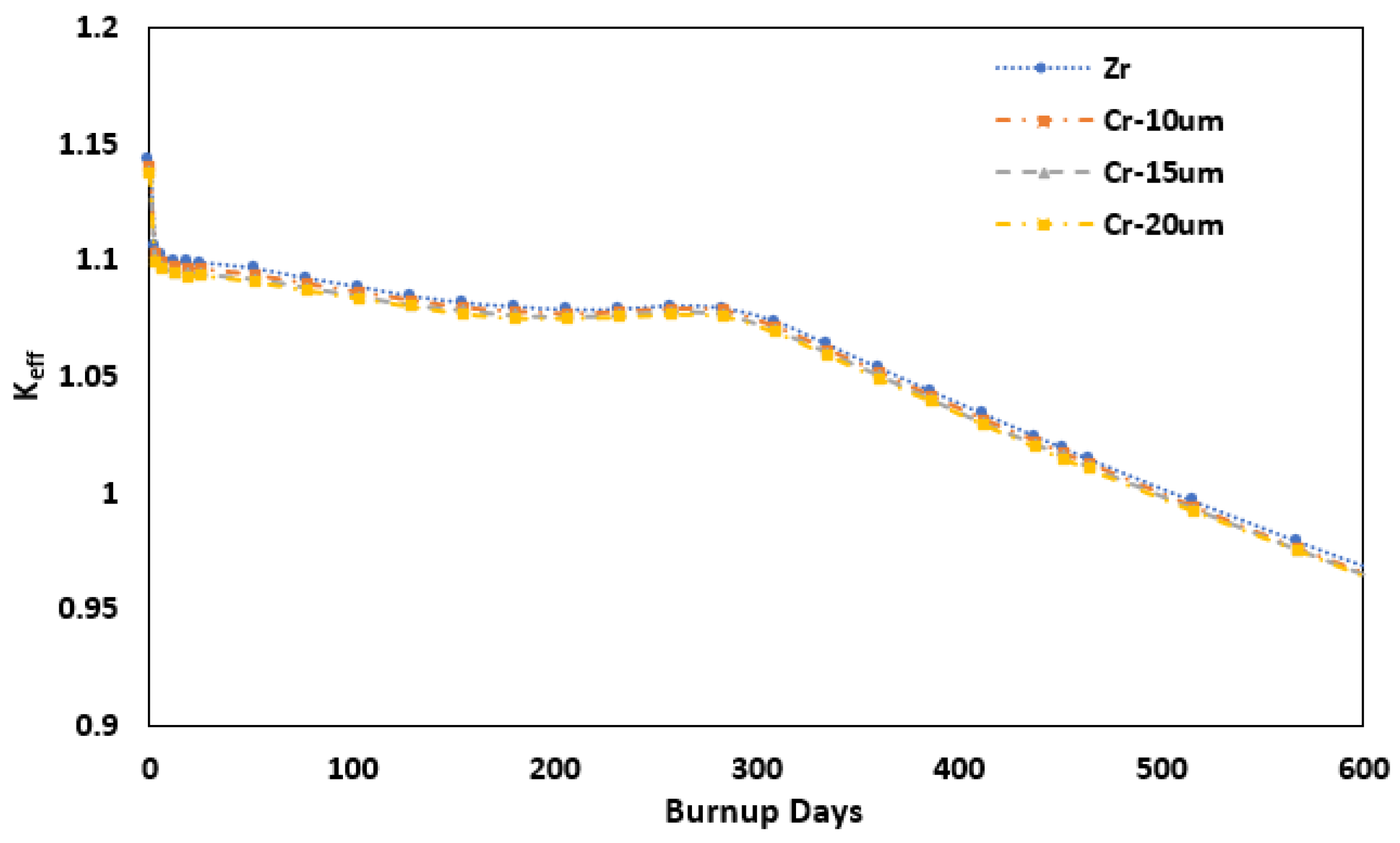

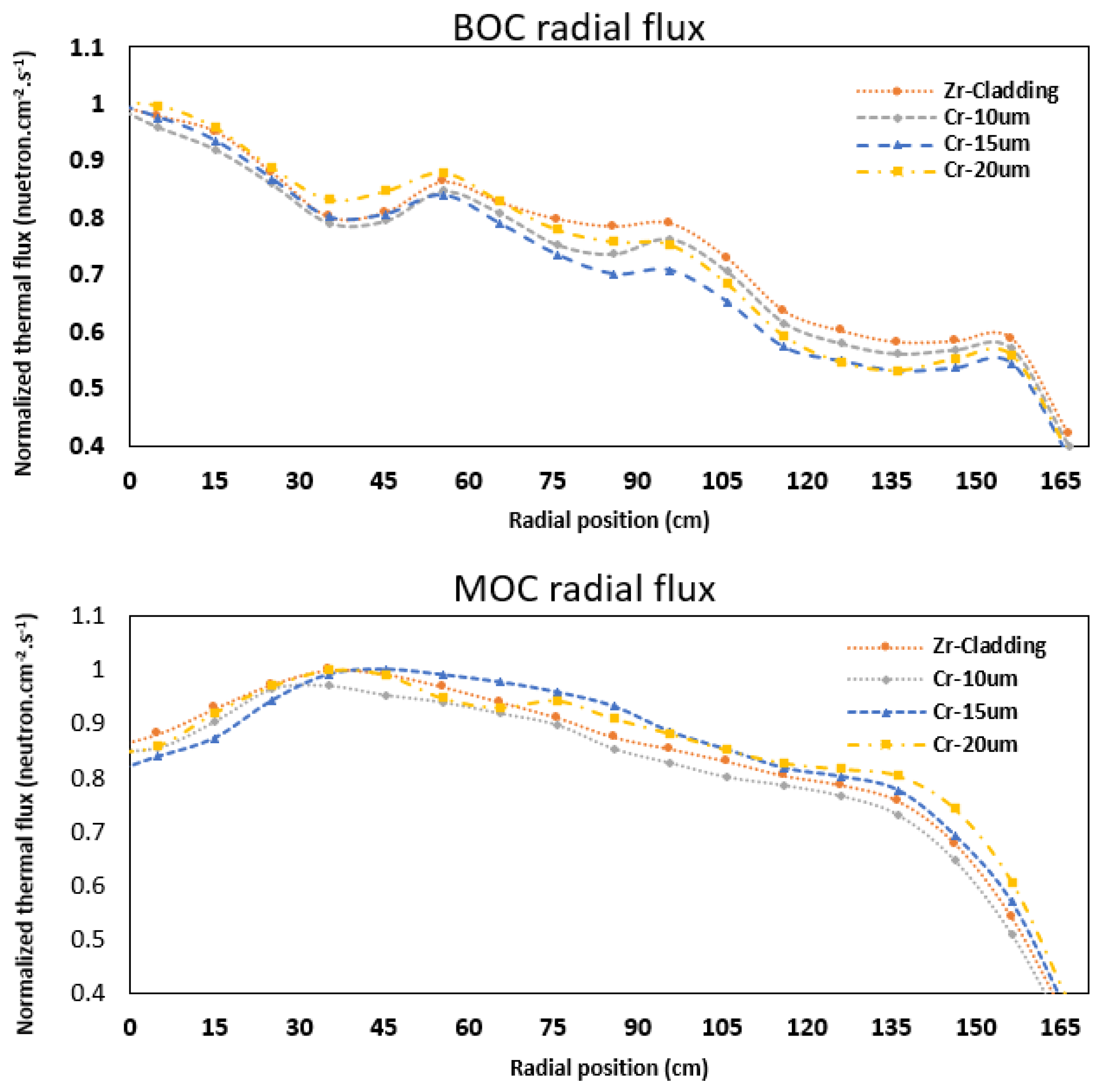
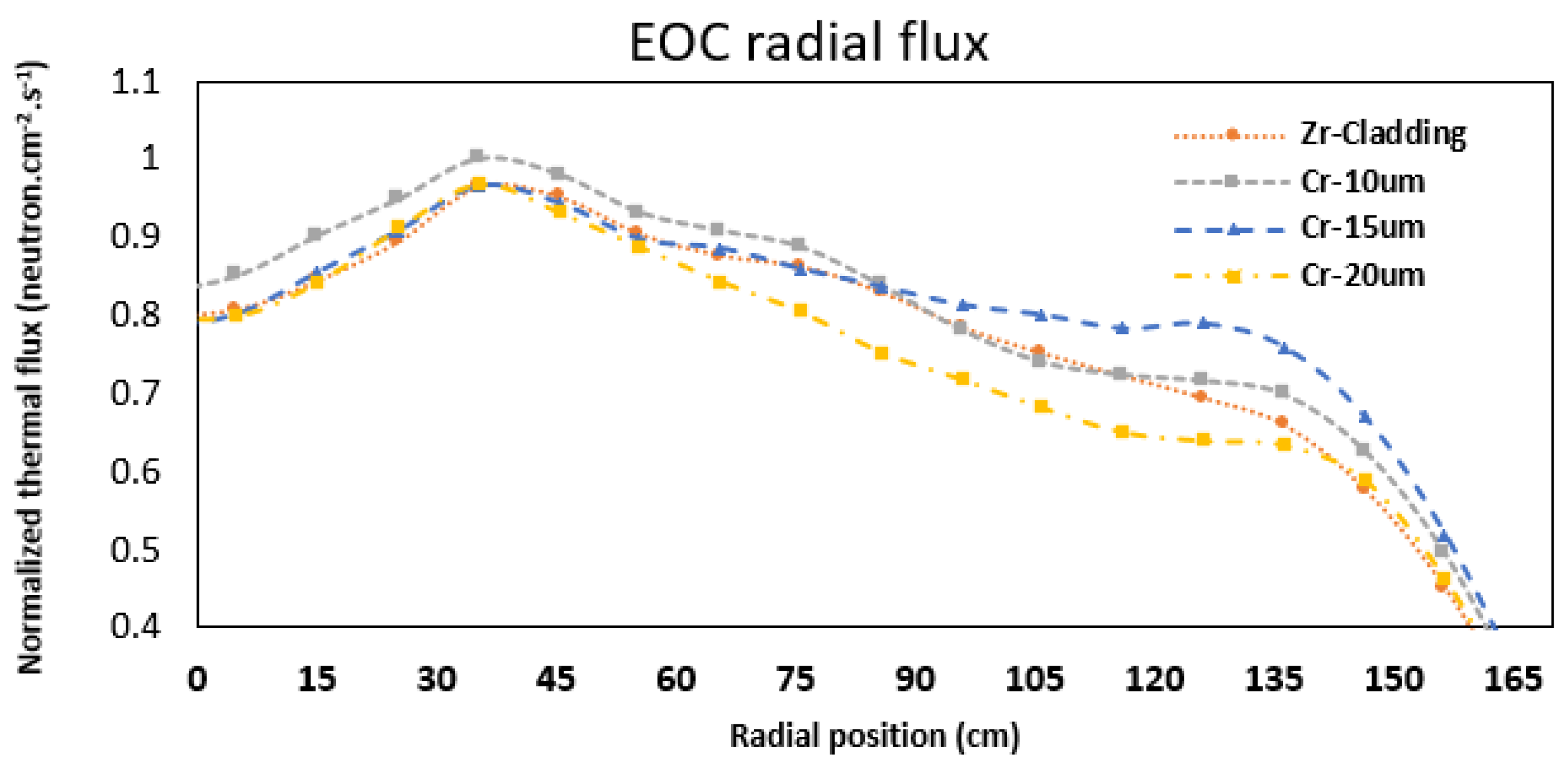
| Item | Value |
|---|---|
| Fuel assemblies | 241 |
| Number of control assemblies | 93 |
| Number of fuel rod locations | 56,876 |
| APR-1400 Core diameter, m | 3.647 |
| Gd2O3 concentration | 8.0 w/o |
| Gd2O3 per assembly | 12, 16 |
| Composition (wt %) | Cross Section (Barn) | |||||
|---|---|---|---|---|---|---|
| Cladding Material | Density (g/cm3) | Zr | Sn | Fe | Cr | |
| Zircaloy-4 | 6.57 | 97.7 | 1.1 | 0.1 | 1.1 | 0.185 |
| Cr | 7.19 | --- | --- | --- | 100.0 * | 3.070 |
| Assembly Type | Number of Assemblies | Enrichment (w/o) | Fuel Rods | Gd2O3 Rods |
|---|---|---|---|---|
| a0 | 85 | 1.68 | 236 | - |
| b0 | 20 | 3.14 | 236 | - |
| b1 | 12 | 3.14/2.64 | 172/52 | 12 |
| b2 | 48 | 3.14/2.64 | 168/52 | 16 |
| c0 | 28 | 3.64/3.14 | 184/52 | - |
| c1 | 16 | 3.64/3.14 | 168/52 | 16 |
| c2 | 24 | 3.64/3.14 | 120/100 | 16 |
| c3 | 8 | 3.64/3.14 | 172/52 | 12 |
| Case # | Pellet Radius (mm) | He Gap (µm) | Clad Thickness (µm) | Coating Thickness (µm) | wt % |
|---|---|---|---|---|---|
| Zr–U | 4.0950 | 85.0 | 570.0 | --- | 1.68, 2.64, 3.14, 3.46 |
| Zr–Cr–U | 4.0950 | 85.0 | 560.0, 555.0, 550.0 | 10.0, 15.0, 20.0 | 1.68, 2.64, 3.14, 3.46 |
| Fuel Enrichment (wt %) | kinf, Zr–U | kinf, Cr-Zr–U | Reactivity Change (pcm) | ||||
|---|---|---|---|---|---|---|---|
| 10 µm | 15 µm | 20 µm | 10 µm | 15 µm | 20 µm | ||
| 1.68 | 1.16109 ± 0.00014 | 1.15742 ± 0.00014 | 1.15550 ± 0.00013 | 1.15341 ± 0.00013 | −317.0 | −484.0 | −666.0 |
| 2.64 | 1.24543 ± 0.00014 | 1.24237 ± 0.00013 | 1.24050 ± 0.00014 | 1.23880 ± 0.00014 | −246.0 | −397.0 | −535.0 |
| 3.14 | 1.31111 ± 0.00013 | 1.30774 ± 0.00013 | 1.30639 ± 0.00014 | 1.30482 ± 0.00014 | −257.0 | −361.0 | −482.0 |
| 3.46 | 1.33424 ± 0.00013 | 1.33139 ± 0.00014 | 1.33012 ± 0.00014 | 1.32860 ± 0.00014 | −214.0 | −310.0 | −425.0 |
| Fuel Enrichment (wt %) | kinf, Zr–U | kinf, Cr-Zr–U | Δρ (pcm) | ||||
|---|---|---|---|---|---|---|---|
| 10 µm | 15 µm | 20 µm | 10 µm | 15 µm | 20 µm | ||
| a0 | 1.03920 ± 0.0003 | 1.03645 ± 0.0003 | 1.03435 ± 0.0003 | 1.03249 ± 0.0003 | −265.0 | −469.0 | −650.0 |
| b0 | 1.23772 ± 0.0004 | 1.23580 ± 0.0004 | 1.23414 ± 0.0004 | 1.23312 ± 0.0004 | −155.0 | −290.0 | −373.0 |
| b1 | 1.05485 ± 0.0006 | 1.05369 ± 0.0006 | 1.05332 ± 0.0006 | 1.05169 ± 0.0006 | −110.0 | −145.0 | −300.0 |
| b2 | 1.00720 ± 0.0007 | 1.00361 ± 0.0007 | 1.00193 ± 0.0006 | 1.00164 ± 0.0006 | −358.0 | −526.0 | −555.0 |
| c0 | 1.26845 ± 0.0004 | 1.26510 ± 0.0004 | 1.26509 ± 0.0004 | 1.26268 ± 0.0005 | −264.0 | −266.0 | −457.0 |
| c1 | 1.05601 ± 0.0005 | 1.05357 ± 0.0005 | 1.05313 ± 0.0006 | 1.05132 ± 0.0007 | −232.0 | −237.0 | −446.0 |
| c2 | 1.04670 ± 0.0007 | 1.04493 ± 0.0007 | 1.04233 ± 0.0006 | 1.04233 ± 0.0006 | −169.0 | −419.0 | −419.0 |
| c3 | 1.10449 ± 0.0005 | 1.10263 ± 0.0005 | 1.10116 ± 0.0006 | 1.10040 ± 0.0006 | −167.0 | −302.0 | −372.0 |
Publisher’s Note: MDPI stays neutral with regard to jurisdictional claims in published maps and institutional affiliations. |
© 2022 by the authors. Licensee MDPI, Basel, Switzerland. This article is an open access article distributed under the terms and conditions of the Creative Commons Attribution (CC BY) license (https://creativecommons.org/licenses/by/4.0/).
Share and Cite
Alrwashdeh, M.; Alameri, S.A. Chromium-Coated Zirconium Cladding Neutronics Impact for APR-1400 Reactor Core. Energies 2022, 15, 8008. https://doi.org/10.3390/en15218008
Alrwashdeh M, Alameri SA. Chromium-Coated Zirconium Cladding Neutronics Impact for APR-1400 Reactor Core. Energies. 2022; 15(21):8008. https://doi.org/10.3390/en15218008
Chicago/Turabian StyleAlrwashdeh, Mohammad, and Saeed A. Alameri. 2022. "Chromium-Coated Zirconium Cladding Neutronics Impact for APR-1400 Reactor Core" Energies 15, no. 21: 8008. https://doi.org/10.3390/en15218008
APA StyleAlrwashdeh, M., & Alameri, S. A. (2022). Chromium-Coated Zirconium Cladding Neutronics Impact for APR-1400 Reactor Core. Energies, 15(21), 8008. https://doi.org/10.3390/en15218008






